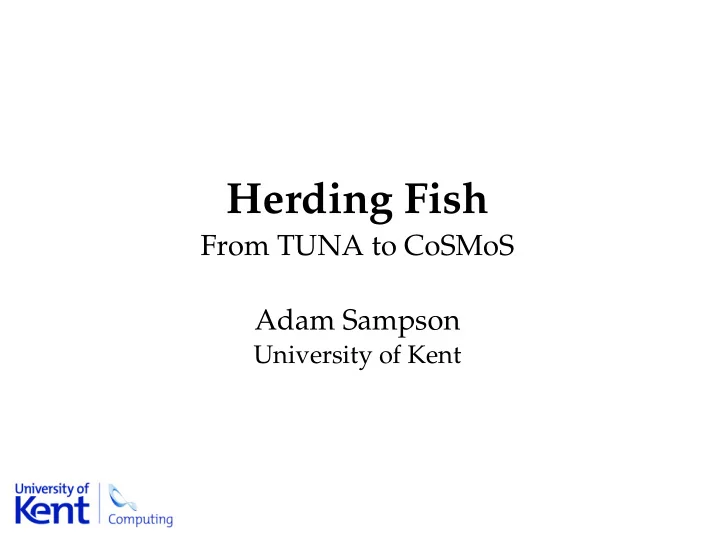

Herding Fish From TUNA to CoSMoS Adam Sampson University of Kent
Introduction ● Partly a wrap-up of TUNA ● Partly an advert for CoSMoS ● Will concentrate on simulation aspects – ... since that's most likely to be of interest to the people here
TUNA ● “Technology Underpinning Nanotech Assemblers” ● Two-year, £60k pilot project ● Studied the feasibility of engineering emergent behaviour in networks of nanites
Case study: haemostasis ● Artificial blood platelets ● Block wounds via an emergent behaviour: – Wounds emit chemical markers – Platelets become sticky in response – Platelets clump together and stick to edges of wound Blood flow Wound
Engineering emergent behaviour ● Emergent behaviour appears everywhere in nature – being able to design it would be really useful ● Break a problem down into processes that solve the problem as an emergent behaviour – i.e. refine emergent behaviour into simple behaviours ● But conventional refinement doesn't work...
Emergence does not refine ● No single refinement step between specification and implementation – Need intermediate environment ● See “Emergent properties do not refine” paper
Modelling languages ● CSP-based approaches – Circus (CSP with Z) – CSP||B (CSP with B) ● Use FDR and Probe for static analysis ● Translate into real code for implementation – Initially by hand – Investigated compiling CSP directly
Blood clotting model ● Stochastic cellular automaton – Lots of states! – Clot movement requires coordination ● Modelled and verified using CSP – 1D, 2D and 3D models
Evolving the model ● Added extra layer of clots above platelets – Synchronises platelet movement – Clots merge when they collide – Behaviour is the same, but the rules have moved layers
Evolving the model ● Environmental layer below platelets – Models chemical diffusion
Process-oriented programming ● Based on CSP and pi-calculus models of concurrency ● Isolated processes communicate via channels ● Everything is an agent!
Languages and toolkits ● occam-pi programming language – Process-oriented – Mobile data provides efficient, safe data sharing – Supports millions of concurrent processes on commodity hardware – Takes advantage of multi-core processors ● Also JCSP, Handel-C, C++CSP, PyCSP...
Dependency tracking ● Only recompute data when necessary – Process network zzz zzz provides dependency graph – Processes “sleep” when nothing is changing
Just-in-time world creation ● Maintaining empty world is expensive ● Create low level processes “just in time” in response to ether higher-level actions ● Allow unused processes to die
Distributing the model ● TUNA cluster – 40 Pentium 4 PCs with gigabit networking – Much cheaper than we expected! ● occam-pi provides transparent networked channels – Same semantics, but much higher latency
Distributing the model ● Can simply split up the existing model ● Some links are now very high-latency, though... Node 1 Node 2 Node 3
Improving efficiency ● For better efficiency, Distributed clot make high-level processes aware of machine boundaries ● Bundle up expensive communications Node 1 Node 2 Node 3
Blood clotting simulation ● Using the tricks above... ● Distributed across 24 nodes of the cluster ● Can do 40,000,000+ processes (at 1.5fps) ● (Nearly!) linear speedup as more nodes are added ● Visualisation based on VTK volumetric renderer
Blood clotting demo
CoSMoS ● “Complex Systems Modelling and Simulation” ● Four-year, £1.1m project ● Inspired by TUNA, but different focus ● Started October 2007
CoSMoS aims ● Design patterns and software framework for modelling and simulating complex systems – Applicable to many different types of systems – Provide a pattern language for modelling – Make efficient, massively-concurrent simulation accessible to scientists from other disciplines
People involved ● York CS/EE/Chem : Susan Stepney, Jon Timmis, Martin Bates, Fiona Polack, Andy Tyrell ● Kent CS : Peter Welch, Fred Barnes ● Christopher Alexander ● Microsoft ● Celoxica
Case studies ● Plants and animals – often grid-based – Fungi – ideal for multi-level modelling ● Liquid crystals – Continuous space, detailed physics model ● Bio-inspired algorithms, such as artificial immune systems – Common concepts between different bio-inspired systems
Distributed continuous space ● The first work we've done for CoSMoS... ● TUNA concentrated on discrete space ● Extend approach to continuous positioning – ... but take advantage of the TUNA techniques
Continuous model of space ● Divide space into cell processes space space space ● Space cells keep track of relative positions of local agents ● Hand off agents as they move between cells
Agent vision ● To see one cell in any Who can Who can he see? he see? direction, you need to space space space ask the cells around you Who can I see? ● Vision requests are forwarded between cells
Boids ● Simple flocking rules – Average position – Average speed – Maintain minimum distance from others
Boids demo
Any questions? This work supported by EPSRC grants EP/C516966/1 and EP/E049419/1 http://www.cosmos-research.org/ First workshop will be at Communicating Process Architectures 2008 September 2008 at York
Recommend
More recommend